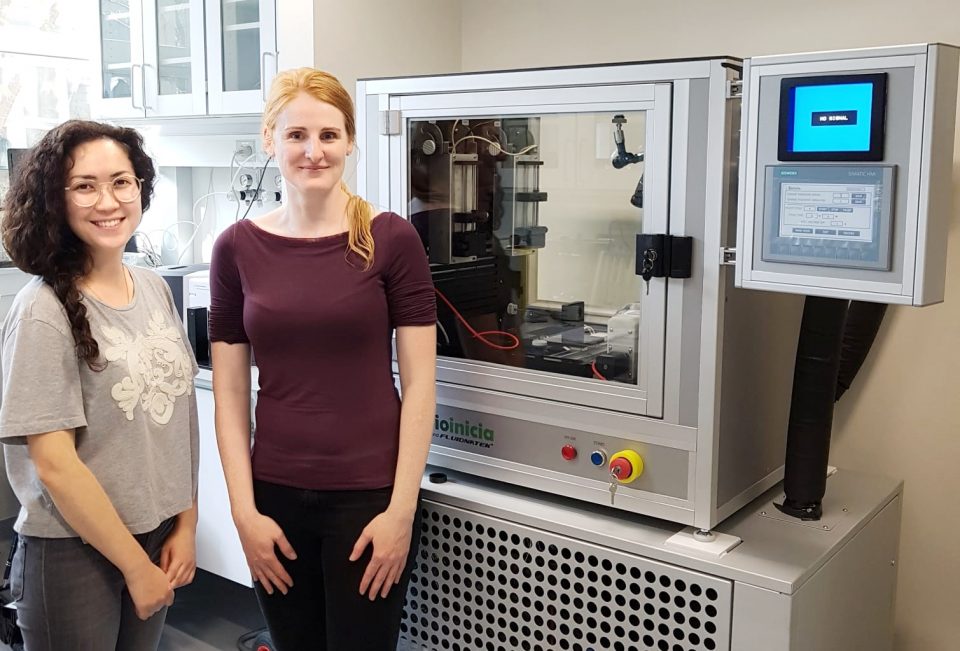20 December 2018
With a grant from the LEO Foundation of almost DKK 1.5m, the LEO Foundation Center for Cutaneous Drug Delivery has bought an electrospinner – an instrument that can be used to prepare biomaterials for replacement of diseased and injured tissue, for example to heal wounds.
Wound healing is a complex biological process involving interaction of different types of cells and mediating substances. Chronic wounds, in particular, are a big burden for the healthcare system. Patients who suffer from diabetes, for instance, often have chronic wounds, which do not heal easily. The reason is that the blood flow in diabetes patients is impaired, which means that wounds are not supplied sufficiently with nutrients and oxygen, leading to delayed wound healing.
But Assistant Professor Andrea Heinz from the LEO Foundation Center for Cutaneous Drug Delivery can do magic with the new electrospinner. The goal of her research is to help improve wound healing by developing biomaterials which are based on natural substances that are well tolerated by the human body .
How does the electrospinner work?
The electrospinner’s collector plate – see how it works
The tissue produced by the electrospinner – how does it look
The instrument holds a syringe containing a solution of a natural substance, for instance a plant protein. The syringe is connected with a needle through tubing, and the solution containing the natural substance is pushed out of this needle. A few centimeters away there is a collector plate made of inert metal. Once the solution is pushed out of the needle, the solvent evaporates and leaves the natural substance to dry and form fine fibrous structures on the collector. The end product looks like a one-layered, very thin tissue.
With the help of the electrospinner, the natural fibers can also be produced in a way to contain medicines such as antibiotics or substances enhancing the wound healing.
“We are developing novel biomaterials based on plant proteins, which contain medicines to heal the wound,” Andrea Heinz explains.
Andrea Heinz and her PhD student Alma Akhmetova are experimenting with different preparation conditions – temperature, concentration of the protein and environmental humidity – to obtain a biomaterial with the perfect properties, such as elasticity and release of the medicine into the wound.
The biomaterials are then tested for their elasticity, and their structure is investigated by electron microscopy, a technique that can visualize the small fibers of the biomaterials, which are only a few micrometers in diameter.
“It is important to know how fast the specific medicine leaves the fiber to achieve a therapeutic effect when the patient applies the biomaterial to the wound” says Andrea Heinz and continues:
“We want to develop a biomaterial, which releases the right amount of medicine at the right time to positively affect wound healing. Therefore, we are doing multiple tests in the laboratory to optimize the biomaterial before we can hold the perfect material for wound healing in our hands.”
So, with this magical electrospinner, Andrea Heinz wants to restore the barrier of the disrupted skin by doing local treatment with minimum side effects.
In the future, the electrospinner will not only be used to prepare modern biomaterials to enhance wound healing, but also to develop modern solid formulations such as tablets. In tablets the electrospinner allows for the preparation of different crystal forms of the active pharmaceutical ingredient(s), which may show better therapeutic effects. Overall, the electrospinner is a versatile machine that can be used for many different purposes in pharmaceutical research and development.
Contact:
Assistant Professor Andrea Heinz, Andrea.Heinz@sund.ku.dk
